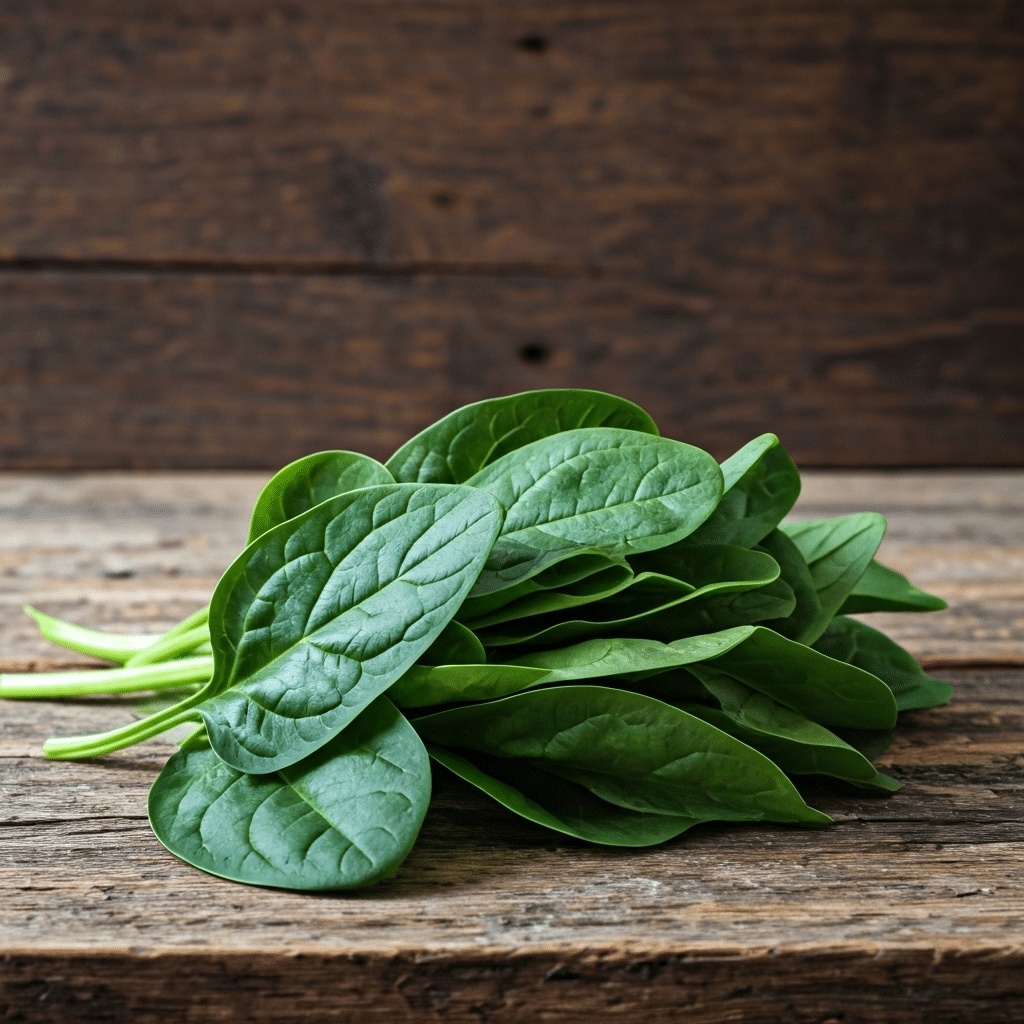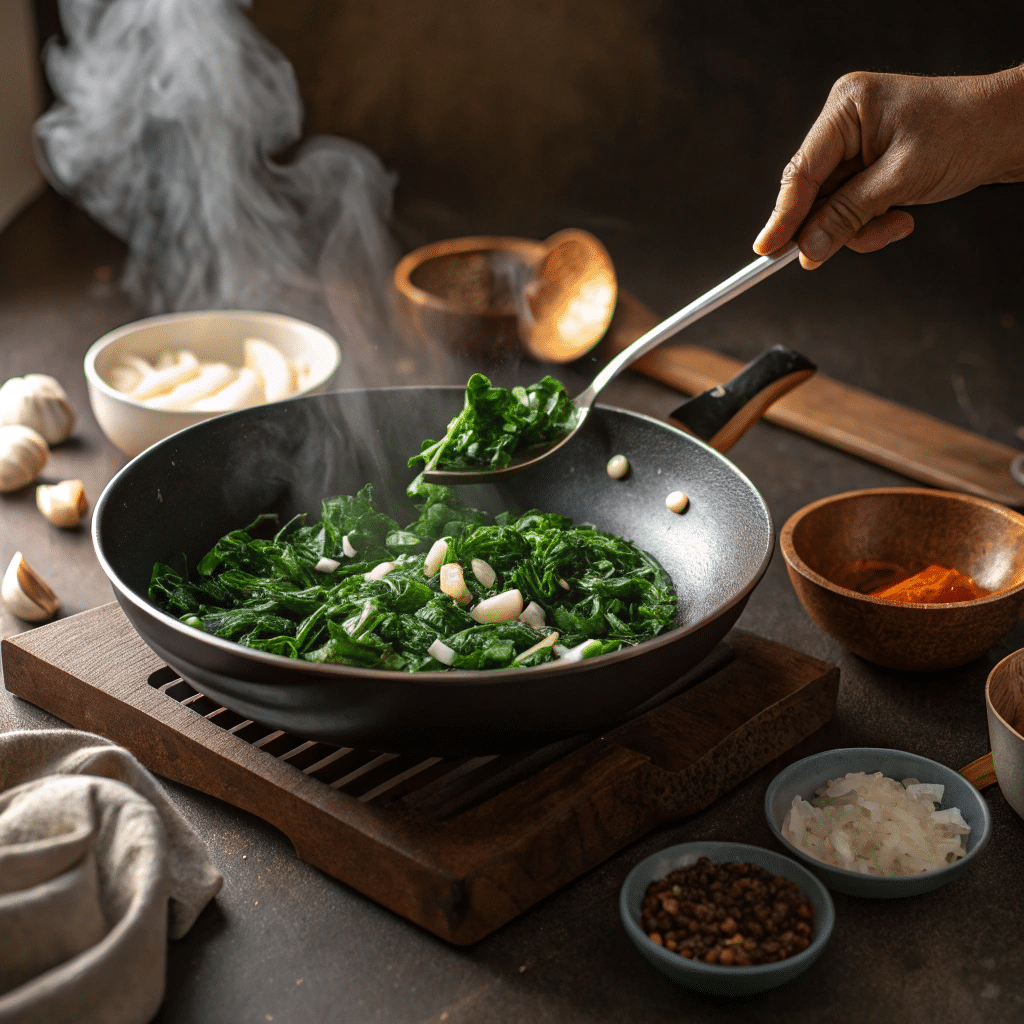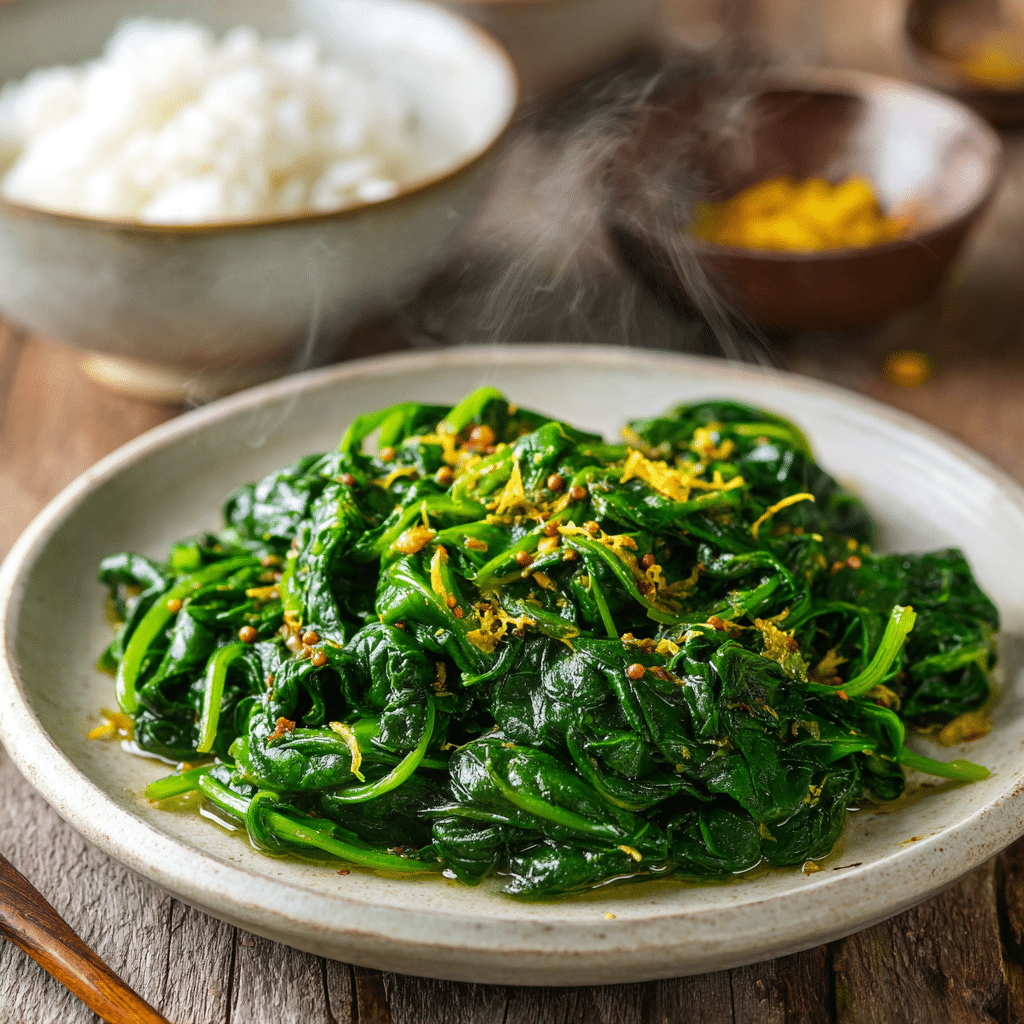Spinach Malabar Recipe: Simple, Tasty, and Nutritious
Jump to Recipe
- Malabar spinach is a green that many people also call vine spinach. It is a very useful and highly healthy leafy green. You can use it in stir fries, curries, or to make a nice side dish with your meal.
- The leaves are thicker and juicier than regular spinach. After cooking, these leaves stay in shape, while regular spinach can become soft.
- Malabar spinach is a good way to get vitamin C, calcium, and manganese. These are great for the body and bring many health benefits.
- This plant grows as a climbing vine and does best when you plant it on trellises. The plant has tender stems that people often cook along with its leaves.
- You can find it in American markets when it is in season. You can buy the fresh leaves to use right away. You can also get seeds if you want to plant Malabar spinach at home.
Keep reading to find out where Malabar spinach comes from, why it is good for you, and to learn easy ways to cook it.
What is Malabar Spinach?

Malabar spinach, also called Basella alba, is a climbing green plant that grows every year. It comes from Asia and people in Indian, Filipino, and Vietnamese cooking often use it. Malabar spinach looks a lot like spinach, but it feels thicker and has more bite to it.
People may also call it vine spinach, Indian spinach, or Ceylon spinach. You will find this plant on trellises where it can grow well as both a decoration and an edible plant. The bright green leaves taste good, have a nice crunch, and work well in foods where you want thicker greens. Malabar spinach is great to cook, or just mix into your favorite dish when you would use other types of spinach.
Origin and Unique Characteristics
Malabar spinach has a long story that covers many places in the world. It comes from warm areas like Africa and India. People there have been growing and eating it for hundreds of years. Basella alba is the type of Malabar spinach that likes hot weather the most. It grows up tall as a climbing vine. In the old days, gardeners would help the plant climb up trellises. That way, they could get more food and also make their gardens look good.
The best thing about Malabar spinach is its tender stems and thick leaves. These stems are different from regular spinach. You can use the stems in cooking if they are still young and soft. When flowers or seeds start to show on the stems, they get tough and are not good to eat. It’s best to throw those away.
There are also red-stemmed kinds called Basella rubra. These look great both in food and in your garden, making plates and gardens brighter. They taste and feel the same as other kinds. This mix of looking nice and being useful is why many people love malabar spinach. It gives your food and garden both color and taste.
Nutritional Benefits for Your Health
Malabar spinach is full of good nutrients. Its thick and juicy leaves have a lot of vitamin C. Malabar spinach can have up to three times more vitamin C than regular spinach. It is also full of calcium and manganese. This helps support your bones and gives you more energy.
These leaves are packed with vitamin A. Malabar spinach has more vitamin A than even kale. It is great for your vision and helps your body fight off sickness. If you want to add something healthy to your food, Malabar spinach is a good pick. It brings both health and rich, good taste to any meal.
When you eat this green vegetable, you get many benefits. It makes your bones stronger and is good for your skin. It is a basic food that gives you a lot. You can stir-fry malabar spinach or cook it in a curry. Malabar spinach is tasty and also good for you. It helps your body and goes well with other foods.
Sourcing Fresh Malabar Spinach in the United States

Finding fresh Malabar spinach in the United States is easy. You will see more of it in stores during warm months. It is a well-liked green in American markets and in stores that sell Asian foods. In Vietnamese stores, you may find it with a label that says “mong toi”.
If you like gardening at home, it is simple to find Malabar spinach seeds online. When you grow it yourself, you get steady access to fresh spinach and tender stems. It is easy to get this leaf, both at stores and by growing it at home. You will see, getting this tasty and good green does not take much work.
Where to Buy and Seasonal Availability
Whether you want to buy malabar spinach or grow it at home, you have a lot of options. In the U.S., you can get this leafy green in Indian and Asian grocery stores. It is often called “mong toi.” Farmers’ markets also have fresh malabar spinach during the best seasonal months, mainly summer.
It is also easy to grow malabar spinach. The plant does well if you start it from seeds or cuttings. Here’s a quick table to help you:
| Where to Find Malabar Spinach | Seasonal Availability and Tips |
|---|---|
| Indian and Asian grocery stores | Peak season: Summer months |
| Farmers’ markets | Look for bright, fresh leaves |
| Online seed vendors | You can grow from seeds or cuttings |
Try to plan early, as malabar spinach keeps its taste and feel best when you get it fresh from a store or grow it in your own garden.
Tips for Selecting and Storing
Getting the best Malabar spinach starts with picking fresh and tender stems. Look for vibrant green leaves that have a shiny look. There should not be any spots or wilted parts. Young and new growth means the malabar spinach is fresh.
To store malabar spinach leaves well, try these steps:
- Keep the leaves in a sealed container in the fridge to stay moist.
- Put the stems in a cup of water if you need to store them for a short time before you use them.
- Do not keep the leaves for over four days if you want to keep their flavor and all the good nutrients.
- Keep malabar spinach away from foods that have strong smells so the leaves keep their own mild scent.
If you store malabar spinach in an organised way, you will be ready to make your favorite dishes every time you want. Keeping your malabar spinach leaves fresh makes your meals taste better and has more nutrition.
Ingredients for a Classic Malabar Spinach Recipe
The best thing about a classic Malabar spinach dish is how simple and tasty it is. The main things you need are fresh Malabar spinach leaves, coconut, and a neutral cooking oil. These give you a good base for this meal. When you add some spices like turmeric, coriander, and mustard, they bring more taste and a warm feeling to the spinach.
If you use shredded coconut, it gives the dish even more flavor. Everyday things like onions and garlic make the smell and taste better. When you put the greens with these warming spices, you get a meal that is both good for you and really filling.
The mix of Malabar spinach, coconut, turmeric, mustard, coriander, and cooking oil makes this dish special every time you cook it.
Key Components and Substitutions
When you use Malabar spinach in classic recipes, you get a rich mix of flavors that go so well together. Here are the main things you need:
- Malabar spinach leaves: These leaves give the dish its thick feel. Regular spinach works if you don’t have Malabar, but it will not have the same juicy taste.
- Coconut: Fresh grated coconut gives many curries a full flavor, but coconut milk can be used for a smoother feel.
- Turmeric and ginger: These give the dish the earthy taste you want. If you run out, some ground cumin can stand in for turmeric.
- Neutral oils or sesame oil: Use one of these to bring out the taste of your spices while cooking.
You can swap some ingredients to make it your own, but it’s best to stay with real Malabar spinach to get the best taste in the end.
Optional Add-ins for Extra Flavor
Boosting flavor is easy with these add-ins you can try:
- Fresh grated coconut brings a sweet taste and a good texture to the side dish or in your curries.
- Mustard seeds: Use them to add crunch and a little bit of heat when you top your food.
- Coriander: Both fresh and ground coriander give off a nice smell and are good on top.
- Sesame oil: It gives a rich earthy taste and goes really well with soft spinach.
- Okra: This helps the food feel right in your mouth, as it mixes well with the greens and makes them less heavy.
These extras can give your malabar spinach dish a deep and rich taste, turning it into something special.
Step-by-Step Cooking Instructions
Cooking Malabar spinach is simple and fast. Begin by heating a wok or skillet on medium-high heat. Add some neutral cooking oil to it. Put ginger and garlic in and stir fry them for a short time. Make sure they do not get too brown. Add Malabar spinach leaves next. Season them with a little turmeric and some spices.
If you want to make curries, use a pressure cooker. This will help the greens and tender stems get soft and nice. When everything is ready, add some coconut or pour in a bit of water. This makes all the flavors blend well. Serve the dish hot so people can enjoy the best taste.
Preparation, Cooking, and Serving Tips
Ready to make a tasty simple stir fry? Here are the best ways to do it:
- Preparation: Cut up the leaves and tender stems. Throw away the tough stems and the ones with blooms.
- Cooking: Let the spices heat up first. If you are using tender stems for slow curries, add a cup of water.
- Serving: Serve your food with rice, or use it as a side dish next to lentils or veggies such as okra.
- Style: You can make it with Konkani-inspired recipes to get bold and rich taste.
Go slow when you cook. This will help keep things fresh and improve the way it feels in your mouth.
Conclusion
To sum up, the Spinach Malabar recipe is a great way to add something nutritious and tasty to your meals. Malabar spinach is unique because of its taste and the good it can do for your body. You can use it in many different ways with other dishes. If you use fresh ingredients and follow each step, you will have a good meal that helps you feel good and tastes nice too. Feel free to be creative.
You can add other things or swap out parts to make this malabar spinach recipe your own. If you want to try new flavors, this malabar dish is a good place to start. Give it a try today!

Simple Malabar Spinach Stir Fry with Coconut and Spices
Ingredients
- 3 cups fresh Malabar spinach leaves washed and chopped
- ½ cup tender stems optional, if soft
- ½ cup grated fresh coconut or ¼ cup coconut milk
- 1 tablespoon neutral oil or sesame oil
- 1 small onion sliced
- 2 garlic cloves chopped
- ½ inch fresh ginger grated or chopped
- ½ teaspoon mustard seeds
- ¼ teaspoon turmeric powder
- ½ teaspoon ground coriander or fresh chopped coriander to finish
- Salt to taste
- Optional: sliced okra or a few curry leaves
Method
- Wash and chop the Malabar spinach leaves. If the stems are young and soft, chop and keep those too. Throw away any tough stems or ones with flowers.
- In a skillet or wok, heat the oil over medium heat. Add mustard seeds and let them pop for a few seconds.
- Stir in garlic, ginger, and onions. Cook for 1–2 minutes until fragrant, but not too brown.
- Sprinkle in turmeric and ground coriander. Stir everything for another 30 seconds to wake up the flavors.
- Add the chopped Malabar spinach (and optional okra). Stir and cook for 3–5 minutes, until the leaves are soft but still have a little bite.
- Mix in the grated coconut or a splash of coconut milk. Stir and cook for another 1–2 minutes. Add salt to taste.
- Serve hot as a side dish with rice, dal, or flatbread. Garnish with fresh coriander if you have it.
Notes
- If using regular spinach, reduce cook time slightly as it wilts faster and doesn’t hold shape like Malabar spinach.
- Coconut milk makes it more creamy, while grated coconut adds texture.
- This dish is naturally vegan and gluten-free.
- Best served fresh, but leftovers keep well for up to 4 days in the fridge.
FAQ
Can I use regular spinach instead of Malabar spinach?
Yes, you can use regular spinach instead of malabar spinach when you make stir fries or curries. But, after cooking regular spinach, the texture will not be as thick or juicy as malabar spinach. Regular spinach wilts fast because it is soft, so be sure to shorten the cooking time.
Is Malabar spinach safe to eat raw?
Absolutely! You can eat malabar spinach raw in salads, but it has a kind of slimy texture that some people do not like. When you cook this spinach, the texture changes and the sliminess goes away. This makes malabar spinach taste better and many people find it easier to enjoy.
What dishes pair well with this recipe?
You can have this Malabar spinach dish with rice, or some Indian lentil foods like dal. You can also try it with flatbreads like chapati. When you use it as a side dish, its taste works well with big curries or lightly spiced vegetable stews. The flavor of Malabar spinach adds something good to these meals.
How do I store leftovers and how long will they keep?
Keep cooked Malabar spinach in an airtight container in the refrigerator. You can store it for up to four days. When you want to eat it again, make sure to heat it well. You can add some water when reheating to keep the spinach soft and nice. This helps keep your malabar spinach fresh and tasting good.
Are there vegan or gluten-free options for this recipe?
Yes, malabar spinach recipes, such as an easy stir fry or curry, are vegan by nature. To make sure the dish is right for people who do not eat gluten, you can use coconut milk, lentils, and fresh spices. These things help keep malabar spinach curry or spinaches authentic and tasty. You get great flavor from the coconut and spices. This is a good way to make a meal that everyone can enjoy.
Related Posts
About The Author
John Watson
John Watson is the passionate food enthusiast behind MePlusFood.com. With a deep love for exploring culinary delights, he shares honest restaurant reviews, mouthwatering recipes, and culinary adventures. Join John on his flavorful journey to savor the world one bite at a time.